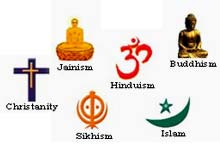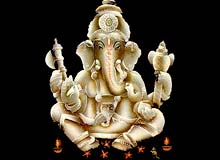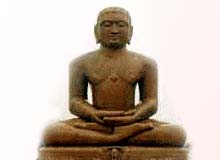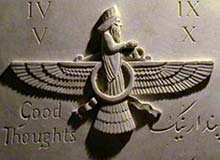Cultural India - Main Religions:
Indian Religions
 India is a land of diversities. This diversity is also visible in the spheres of religion. The major religions of India are Hinduism (majority religion), Islam (largest minority religion), Sikhism, Christianity, Buddhism, Jainism, Zoroastrianism, Judaism and the Bahá'í Faith. India is a land where people of different religions and cultures live in harmony. This harmony is seen in the celebration of festivals. The message of love and brotherhood is expressed by all the religions and cultures of India.
India is a land of diversities. This diversity is also visible in the spheres of religion. The major religions of India are Hinduism (majority religion), Islam (largest minority religion), Sikhism, Christianity, Buddhism, Jainism, Zoroastrianism, Judaism and the Bahá'í Faith. India is a land where people of different religions and cultures live in harmony. This harmony is seen in the celebration of festivals. The message of love and brotherhood is expressed by all the religions and cultures of India.Whether it's the gathering of the faithful, bowing in prayer in the courtyard of a mosque, or the gathering of lamps that light up houses at Diwali, the good cheer of Christmas or the brotherhood of Baisakhi, the religions of India are celebrations of shared emotion that bring people together. People from the different religions and cultures of India, unite in a common chord of brotherhood and amity in this fascinating and diverse land.
Buddhism
At present Buddhism is one of the major world religions. The philosophy of Buddhism is based on the teachings of Lord Buddha, Siddhartha Gautama (563 and 483 BC), a royal prince of Kapilvastu, India. After originating in India, Buddhism spread throughout the Central Asia, Sri Lanka, Tibet, Southeast Asia, as well as the East Asian countries of China, Mongolia, Korea, Japan and Vietnam.
Christians
Christianity is one of the prominent religions in India. At present there are about 25 million Christians in India. It is interesting to note that the Christian population in India is more than the entire population of Australia and New Zealand or total population of a number of countries in Europe.
Hinduism
Hinduism is the oldest religion in the world. Hinduism is world's third largest religion after Christianity and Islam. Hinduism is the dominant religion in India, where Hindus form about 84 per cent of the total population. Hinduism is also known as "Sanatan Dharma" or the everlasting religion.
Islam
One of the prominent religions of India, Islam forms about 12 per cent of India's population. Though India's contact with Islam had begun much earlier, the real push came in the 8th century when the province of Sindh was conquered. Though the Muslims form only 12 per cent of the total population of India but the influence of Islam on Indian society is much stronger.
Jainism
Jains form less than one percent of the Indian population. For centuries, Jains are famous as community of traders and merchants. The states of Gujarat and Rajasthan have the highest concentration of Jain population in India. The Jain religion is traced to Vardhamana Mahavira (The Great Hero 599-527 B.C.).
Sikhism
Sikhs form about 2 per cent of Indian population. In comparison to other religions, Sikhism is a younger religion. The word 'Sikh' means a disciple and thus Sikhism is essentially the path of discipleship. The true Sikh remains unattached to worldly things.
Zoroastrian
Though the total number of Zoroastrians in Indian population is very less yet they continue to be one of the important religious communities of India. According to the 2001 census, there were around 70,000 members of the Zoroastrian faith in India. Most of the Parsis (Zoroastrians) live in Maharashtra (mainly in Mumbai) and the rest in Gujarat.
Hinduism
 Hinduism is the oldest religion in the world. Hinduism is world's third largest religion after Christianity and Islam. Hinduism is the dominant religion in India, where Hindus form about 84 per cent of the total population. Hinduism is also known as "Sanatan Dharma" or the everlasting religion. Hindu religion is based on the concept that human and animal spirits come back to earth to live many times in different forms. The Hindus believe that a soul moves up and down hierarchy on the basis of behavior.
Hinduism is the oldest religion in the world. Hinduism is world's third largest religion after Christianity and Islam. Hinduism is the dominant religion in India, where Hindus form about 84 per cent of the total population. Hinduism is also known as "Sanatan Dharma" or the everlasting religion. Hindu religion is based on the concept that human and animal spirits come back to earth to live many times in different forms. The Hindus believe that a soul moves up and down hierarchy on the basis of behavior.According to Hinduism a person is born into the higher class because he/she must have done good deeds in past life whereas a person is born into poverty and shame because of misdeeds in past life. Central to Hinduism are the concepts of reincarnation, the caste system, merging with Brahman, finding morality, and reaching Nirvana (the peaceful escape from the cycle of reincarnation). According to Hinduism the paths to salvation include rituals, devotion and the way of knowledge (realization of reality and self-reflection). If the practitioner follows the paths of these ways, salvation can be achieved.
The main Hindu scriptures are Sruti (what is heard), Smriti (what is remembered) the Vedas, the Brahmanas, the Upanishads, the Puranas and epics. The Sruti include deeply religious things communicated to a seer and recorded. The Vedas, the religious writings, include mantras (hymns of praise), brahmanas (sacrificial rituals) and Upanishads (108 sacred teachings). The Smriti include the law (books of laws), puranas (myths, stories, legends) and epics (sets of holy myths including Ramayana and Mahabharata).
Islam Religion
 One of the prominent religions of India, Islam forms about 12 per cent of India's population. Though India's contact with Islam had begun much earlier, the real push came in the 8th century when the province of Sindh was conquered. Though the Muslims form only 12 per cent of the total population of India but the influence of Islam on Indian society is much stronger. The main reason for this strong influence is that over a long period of time many Muslim rulers ruled in different parts of India.
One of the prominent religions of India, Islam forms about 12 per cent of India's population. Though India's contact with Islam had begun much earlier, the real push came in the 8th century when the province of Sindh was conquered. Though the Muslims form only 12 per cent of the total population of India but the influence of Islam on Indian society is much stronger. The main reason for this strong influence is that over a long period of time many Muslim rulers ruled in different parts of India. The country with the largest Muslim population today is Indonesia and it is followed by India. The followers of Islamic religion, Muslims constitute India's largest religious minority. They number about 105 million. This makes India one of the largest Islamic nations in the world. India has had two Muslim Presidents and several cabinet and state chief ministers since Independence. Besides, Muslims in India have always held various responsible positions and posts in all walks of life.
In India the Muslims are divided into two main sects- Sunni and Shia. Each one of these two sects has many different schools. Along with these main divisions, the Indian Muslims also have other divisions. It is mainly because different communities that adopted Islam have different names. The Bohra and the Khoja Muslim communities are prominent in west India. The Nawait call themselves as descendants of Arab and Persian immigrants.
In south India in the state of Kerala, the famous Mopillah community is said to have descended from Arab merchants. Another well known Indian Muslim community is Pathan. The Pathans are Muslims who arrived from Afghanistan to India. The Pathans put their surname as Khan. They are regarded as brave, honest and righteous.
Christianity
 Christianity is one of the prominent religions in India. At present there are about 25 million Christians in India. It is interesting to note that the Christian population in India is more than the entire population of Australia and New Zealand or total population of a number of countries in Europe. Kerala, Goa and Mizoram states have high concentration of Christian population in India. Kerala has the largest number of Christians among the states. Christians including Catholics, Orthodox and Protestants form the third largest group in India.
Christianity is one of the prominent religions in India. At present there are about 25 million Christians in India. It is interesting to note that the Christian population in India is more than the entire population of Australia and New Zealand or total population of a number of countries in Europe. Kerala, Goa and Mizoram states have high concentration of Christian population in India. Kerala has the largest number of Christians among the states. Christians including Catholics, Orthodox and Protestants form the third largest group in India. About 73% of the Christians in India are Catholics. The Catholic Church in India is composed of three individual Churches- Latin, Malabar and Malankara. Christian community includes Syrian Christians, Knanaya Christians, Goan Christians, Tamil Christians, Anglo-Indians, Naga Christians etc. All these Christian communities differ in language, social customs and economic status. It is not surprising that Christians in India occupy high positions like cabinet ministers, governors, high court judges, University vice-chancellors, bureaucrats etc.
St. Thomas, one of the twelve apostles of Jesus Christ, came to India in 52 A.D. and landed at Kodungallur on the Malabar Coast. He preached the Gospel to the Brahmin families of Kerala. St. Thomas established seven Churches at: Kodungallur, Kottakkavu, Palayur, Kollam, Kokkamangalam, Niranam and Chayil. St. Thomas came to India when many European countries had not yet become Christian and so those Indians who trace their Christianity to him have a longer history and a higher ancestry than that of Christians of many of the European countries."
Sikhism
 Sikhs form about 2 per cent of Indian population. In comparison to other religions, Sikhism is a younger religion. The word 'Sikh' means a disciple and thus Sikhism is essentially the path of discipleship. The true Sikh remains unattached to worldly things. The Sikh must do his duty to his family and to the community. Sikhism was established by Guru Nanak. It preaches the existence of only one God and teaches universally acceptable ideals of honesty, compassion, humbleness, piousness, social commitment and tolerance for other religions.
Sikhs form about 2 per cent of Indian population. In comparison to other religions, Sikhism is a younger religion. The word 'Sikh' means a disciple and thus Sikhism is essentially the path of discipleship. The true Sikh remains unattached to worldly things. The Sikh must do his duty to his family and to the community. Sikhism was established by Guru Nanak. It preaches the existence of only one God and teaches universally acceptable ideals of honesty, compassion, humbleness, piousness, social commitment and tolerance for other religions. Guru Nanak Dev included the good beliefs of other religions in Sikhism. Some the inhuman Indian customs like the caste system and Sati (burning of the widow) was discarded in Sikhism. In Sikhism everyone has equal rights irrespective of caste, creed, color, race, sex or religion. Sikhism rejects unnecessary rituals. A Sikh believes in one God and in the teachings of the Gurus, which are embodied in Sri Guru Granth Sahib.
Gurdwara is Sikh's place of worship. As Sikhism believes that God is everywhere it does not support pilgrimage to holy places. The Hari Mandir (the Golden temple) at Amritsar is considered the holiest shrine of Sikhism. One of the distinct features of Sikhism is the common kitchen called Langar. In every Gurdwara there is a Langar. Every Sikh is expected to contribute in preparing the meals in the free kitchen.
Guru Nanak Dev, the founder of the Sikh religion, was its first Guru. After him there were nine more Gurus who were the highest religious authority of the Sikhs. The last Guru of the Sikhs, Guru Gobind Singh, declared that after him the Guru of the Sikhs would be the holy book of Sikhism, Guru Granth Sahib. Guru Granth Sahib is written in Gurumukhi script. The Guru Granth Sahib includes the writings of the Sikh Gurus and the writings of Hindu and Muslim saints and mystics. The writings of Guru Govind Singh appear in a separate book called "Dasam Granth".
Sikh Takhts
Takht literally means a throne. Takhts are considered the seats of Sikh religious authority. Important decisions related to the religious and social life of the Sikh community is taken at Takhts. The first and the most important Takht was established by Guru Hargobind in 1609. This Takht is called the 'Akal Takht' and is located just opposite the Harmandar Sahib - The Golden Temple, Amritsar. The second seat of authority is called "Takht Sri Patna Sahib".
Takht Sri Damdama Sahib is situated in the Talwandi village near Bhatinda. Here, Guru Gobind Singh stayed for about a year and compiled the final edition of the Guru Granth Sahib. Takht Sri Keshgarh Sahib is situated at Anandpur Sahib. It is the place where the Khalsa (the Sikh brotherhood) was born in 1699 by Guru Govind Singh. Takht Sri Hazoor Sahib is located on the banks of Godavari River in Maharashtra. This is the place where Guru Gobind Singh left for Heavenly abode.
Buddhism
 At present Buddhism is one of the major world religions. The philosophy of Buddhism is based on the teachings of Lord Buddha, Siddhartha Gautama (563 and 483 BC), a royal prince of Kapilvastu, India. After originating in India, Buddhism spread throughout the Central Asia, Sri Lanka, Tibet, Southeast Asia, as well as the East Asian countries of China, Mongolia, Korea, Japan and Vietnam. Buddhism owes its origin to the socio-economic conditions prevailing in India at that point of time.
At present Buddhism is one of the major world religions. The philosophy of Buddhism is based on the teachings of Lord Buddha, Siddhartha Gautama (563 and 483 BC), a royal prince of Kapilvastu, India. After originating in India, Buddhism spread throughout the Central Asia, Sri Lanka, Tibet, Southeast Asia, as well as the East Asian countries of China, Mongolia, Korea, Japan and Vietnam. Buddhism owes its origin to the socio-economic conditions prevailing in India at that point of time. The founder of Buddhism, Siddhartha Gautama was a prince of the Sakya tribe. At the age of twenty nine he left the comforts of his home to seek answer to the cause of human sufferings. Gautama became the enlightened one, the Buddha, after wandering and meditation for six years. On the full moon of May, with the rising of the morning star, Siddhartha attained knowledge at Bodh Gaya. Gautama Buddha delivered his first sermon at Sarnath, near Varanasi. To preach his religion, Buddha wandered in the North East India for about 40 odd years. His hard work bore fruit and a community or Sangha of monks and nuns developed around him. The Sangha pursued practice and propagation of Buddhism.
The fundamental principle of Buddhism is to follow the middle path. Buddhism teaches its followers to perform good and wholesome actions and to purify and train the mind. These practices are aimed at ending the suffering of cyclic existence. Buddhist emphasizes the principles of harmlessness and moderation. Buddhism does believe in the existence of supernatural beings but it does not ascribe the power for creation, salvation or judgment to them. Buddhism believes that the supernatural beings have the power to affect only worldly events.
Four Noble Truths Of Buddhism
- Life is suffering;
- Suffering is due to attachment;
- Attachment can be overcome
- There is a path for accomplishing this.
Eightfold Path Of Buddhism
- Right view is the true understanding of the four noble truths.
- Right aspiration is the true desire to free oneself from attachment, ignorance, and hatefulness.
- Right speech involves abstaining from lying, gossiping, or hurtful talk.
- Right action involves abstaining from hurtful behaviors, such as killing, stealing, and careless sex.
- Right livelihood means making your living in such a way as to avoid dishonesty and hurting others, including animals.
- Right effort is a matter of exerting oneself in regards to the content of one's mind: Bad qualities should be abandoned and prevented from arising again; Good qualities should be enacted and nurtured.
- Right mindfulness is the focusing of one's attention on one's body, feelings, thoughts, and consciousness in such a way as to overcome craving, hatred, and ignorance.
- Right concentration is meditating in such a way as to progressively realize a true understanding of imperfection, impermanence, and non-separateness.
Jainism Religion
 Jains form less than one percent of the Indian population. For centuries, Jains are famous as community of traders and merchants. The states of Gujarat and Rajasthan have the highest concentration of Jain population in India. The Jain religion is traced to Vardhamana Mahavira (The Great Hero 599-527 B.C.). Mahavira was the twenty-fourth and last of the Jain Tirthankars. Mahavira was born in a ruling family of Vaishali, located in the modern state of Bihar, India. At the age of thirty, Mahavira renounced royal life and devoted himself to the task of discovering the meaning of existence. At the age of 42 he attained enlightenment and spent the rest of his life meditating and preaching Jainism.
Jains form less than one percent of the Indian population. For centuries, Jains are famous as community of traders and merchants. The states of Gujarat and Rajasthan have the highest concentration of Jain population in India. The Jain religion is traced to Vardhamana Mahavira (The Great Hero 599-527 B.C.). Mahavira was the twenty-fourth and last of the Jain Tirthankars. Mahavira was born in a ruling family of Vaishali, located in the modern state of Bihar, India. At the age of thirty, Mahavira renounced royal life and devoted himself to the task of discovering the meaning of existence. At the age of 42 he attained enlightenment and spent the rest of his life meditating and preaching Jainism.Jainism rests on a real understanding of the working of karma, its effects on the living soul and the conditions for extinguishing action and the soul's release. Jainism considers the soul as a living substance that combines with various kinds of non-living matters. The Jain religion rests on complete inactivity and absolute nonviolence (ahimsa) against all living beings. It is evident from the Jain monks and nuns wearing face masks to avoid inhaling small organisms. It is for the same reason all practicing Jains try to remain vegetarians.
The Jain community evolved into two main divisions- the Digambara or "sky-clad" monks do not wear clothes and the Svetambara or "white-clad" monks and nuns, who wear white clothes and carry bowls for collecting food. For centuries Western and southern India have been Jain strongholds. In the mid-1990s, there were about 7 million Jains, the majority of whom live in the states of Maharashtra (mostly in Bombay), Rajasthan, and Gujarat. Karnataka, conventionally a stronghold of Digambaras, also has a considerable Jain community.
Though the Jain shrines include images of the Tirthankars, yet they are not worshiped but remembered and revered. Daily rituals of the Jains may include meditation, bathing the images, offering food, flowers and light lamps for the images. It is interesting to note that the Jains also worship local gods and participate in Hindu or Muslim celebrations without compromising their fundamental path. The Jains celebrate the five major events in the life of Mahavira- conception, birth, renunciation, enlightenment, and final release after death.
Major Jain pilgrimage destinations in India are Palitana, Ranakpur, Shravanbelagola, Dilwara Temple, Khandagiri Caves and Udayagiri Caves.
Zoroastrian Religion
 Though the total number of Zoroastrians in Indian population is very less yet they continue to be one of the important religious communities of India. According to the 2001 census, there were around 70,000 members of the Zoroastrian faith in India. Most of the Parsis (Zoroastrians) live in Maharashtra (mainly in Mumbai) and the rest in Gujarat. Zoroastrians or Parsis are mainly the descendants of the tenth-century immigrants from Persia. Though the number of Zoroastrians in India is alarmingly low yet they wield great influence because of their financial position. The level of Zoroastrian population is ascribed to migration, low birth, late marriages, non-marriages, divorce and infertility.
Though the total number of Zoroastrians in Indian population is very less yet they continue to be one of the important religious communities of India. According to the 2001 census, there were around 70,000 members of the Zoroastrian faith in India. Most of the Parsis (Zoroastrians) live in Maharashtra (mainly in Mumbai) and the rest in Gujarat. Zoroastrians or Parsis are mainly the descendants of the tenth-century immigrants from Persia. Though the number of Zoroastrians in India is alarmingly low yet they wield great influence because of their financial position. The level of Zoroastrian population is ascribed to migration, low birth, late marriages, non-marriages, divorce and infertility. In the beginning, the Parsis or Zoroastrians were engaged in shipbuilding and trade activities and were located in the ports and towns of Gujarat. Slowly and gradually their entrepreneurial skills saw them expanding and controlling trade and commerce. With colonial expansion they got more trading opportunities and substantial number of Parsis moved to Bombay. From then onwards Mumbai or Bombay served as a base for expanding their business activities throughout India and abroad. Sanjan, Nausari and Udvada towns in Gujarat are of great importance to Parsis as they served as community centers before the Zoroastrians or Parsis migrated to Bombay in the nineteenth century
The Zoroastrians enjoyed the benefit of Western commercial contacts and English-language education and expanded their commercial dominance rapidly and became the most cosmopolitan community in India during the British rule. In modern India, Parsis are the most urban, elite, and wealthy of almost all the religious groups of India. Parsis have played an important role in the development of trade, industry, finance, and philanthropy, which has earned them an important place in the India's social and economic life. Many of the Parsis or Zoroastrians have earned accolades in government services and law.
The religious book of the Parsis is called source the Avesta, which includes a number of sections in archaic language attributed to Zoroaster and which preserve the cult of the fire sacrifice as the focus of ritual life. The religious and ritual life of pious Parsis revolves around sacred fires. The most important rite for most lay Parsis is the Navjote. It is performed when a person is between the age group of seven and fifteen. It initiates the young person into the adult community of the Parsis. The Navjote ceremony involves purifying bathing, reciting Avesta -based scriptures, and being invested with a sacred shirt and waist thread (kusti) that should always be worn after the ceremony. The dead Parsis are disposed of by exposure to vultures Dakhmas (or towers of silence).
https://linksredirect.com/?pub_id=11719CL10653&url=http%3A//in.hotels.com/

1 comment:
Thanks For Sharing Such a Nice Information For Indian Religions.
Same Day Agra Tour By Car
Post a Comment